John Irwin, who led The Hopkins Review from its rebirth in 2008, will retire from teaching at Johns Hopkins University this spring. David Yezzi took over the reins of the journal in 2015. A well-known poet, actor and editor, Yezzi joined the Johns Hopkins faculty in 2013. Yezzi joined us to talk about his new position and the special issue devoted to Irwin’s impact on the field.
Tag Archives: Literature
The Hopkins Review Enters New Era
Comments Off on The Hopkins Review Enters New Era
Filed under Journals, Journals, Literature, Poetry, Poetry, Uncategorized
Digging Into Graphic Narrative
Late in 2015, the journal South Central Review published a special issue on “Graphic Narrative.” The issue featured seven essays and two book reviews on the growing field of scholarship focused on this area of publishing. Nicole Stamant, assistant professor of English at Agnes Scott College, served as guest editor and joined us for a Q&A to take a deeper look at the issue.
How did this issue come together?
 NS: In 2013, the Editor of South Central Review, Joe Golsan, was visiting the Victoria and Albert Museum, in London. That year, there was a special, interactive exhibit that featured graphic narratives and it got him thinking about how the journal could engage these kinds of stories. The journal is devoted to the intersection of culture and academia, and this special issue is a great manifestation of such dedication. After this experience at the Victoria and Albert, Joe spoke to Nicholas Lawrence, the journal’s Managing Editor, who got in touch with me. Much of my research and teaching revolve around graphic narrative, and when Nick indicated that there was a desire for South Central Review to assemble a special issue on graphic narrative, I thought it was a fantastic idea.
NS: In 2013, the Editor of South Central Review, Joe Golsan, was visiting the Victoria and Albert Museum, in London. That year, there was a special, interactive exhibit that featured graphic narratives and it got him thinking about how the journal could engage these kinds of stories. The journal is devoted to the intersection of culture and academia, and this special issue is a great manifestation of such dedication. After this experience at the Victoria and Albert, Joe spoke to Nicholas Lawrence, the journal’s Managing Editor, who got in touch with me. Much of my research and teaching revolve around graphic narrative, and when Nick indicated that there was a desire for South Central Review to assemble a special issue on graphic narrative, I thought it was a fantastic idea.
No specific direction or subgenre was indicated for the special issue, which I thought was exciting, too. As I write in the introduction, while we have seen a real increase in overall scholarship about graphic narrative, it’s a particular thrill to have as storied a journal as South Central Review take an interest in it. Frankly, such an interest is a testament to the journal itself—they’re committed to being on the cutting edge of contemporary scholarship. Although my own research focuses on life writing and graphic memoir, I quite liked the idea of an open discussion about graphic narrative and was optimistic that we would get a real variety of analyses. We put out a general call for articles about graphic narrative and received some great submissions. I organized the issue from there, based on trends featured in the essays: an investment both in the unique potential and power of graphic narrative and in how graphic narratives foreground negotiations of representation, of structure and form, of visibility, of the archive, and of publishing itself.
In the intro, you mention that this issue takes for granted that graphic narrative scholarship is needed. How important is it that this kind of analysis is more accepted now?
NS: To be honest, it’s enormously important. We are lucky to be in a literary moment of true proliferation, in a moment in which stories are being told by people who may have had a much more difficult—or impossible—time sharing their stories at other points, and in all kinds of ways. Graphic narrative is one such form, and the fact that we are taking this form seriously, in all of its variability, allows us as readers and thinkers new ways to understand being in this world. We live in a moment saturated with the confluence of text and image, and it makes sense that our storytelling strategies would reflect such intersections. So, paying attention to graphic narrative matters generally; in scholarship, it is perhaps even more crucial to consider issues of representation and diversity of storytelling. Graphic narrative is fundamentally cross-disciplinary, negotiating text and image, and graphic narrative scholarship has the potential to help articulate what it is that makes graphic narrative so special. In addition, scholarship can influence pedagogy, and one of the hopes for this special issue is that these articles allow those who may not be steeped in Comics Studies the opportunity to learn a bit more about what is happening in contemporary graphic narrative and how these kinds of texts can be incorporated into classrooms and shared with students.
What new ground is broken by the articles in this issue?
NS: Importantly, this issue includes articles about outstanding texts that do not yet have a large scholarly presence: Sinéad Moynihan’s analysis of Mat Johnson and Warren Pleece’s Incognegro and Jim Coby’s discussion of Josh Neufeld’s A.D.: New Orleans After the Deluge do a lot of work in the service of these books and these stories. These articles substantively provide nuanced negotiations of history, experience, technology (as with Neufeld’s hyperlinked text), and literary tradition, and it is a real privilege to have had the chance to put them into print. For the contributions about texts that are more well known, the articles add complexity to the conversations: this is particularly true with Robert Hutton’s consideration of the publishing industry—he uses Art Spiegelman’s Maus as a test case for its significance in our understanding of graphic narratives—and Frederik Byrn Kohlert’s negotiation of trauma studies in Phoebe Gloeckner’s work. There are also articles that posit new theoretical foundations about graphic narrative; Nancy Pedri’s work on ocularity and focalization and K.W. Eveleth’s presentation of labyrinthine aesthetics are incredibly interesting and useful. They all work together to, I hope, present readers with a microcosm of the discussions happening elsewhere in scholarship and in classrooms, and they’ve already changed the way I understand and teach these texts.
What does the future hold for serious examination of graphic narratives?
NS: It is such a fantastic time to be reading, creating, and writing about graphic narratives! There are so many important works that academia hasn’t quite discovered, yet, or works that we haven’t given the real attention they deserve. Contemporary graphic narrative allows for untold new ways of considering experience, and continuing studies of comics and graphic narrative should demand close attention to issues of (re)presentation more generally. I hope that we will continue to recover comics and graphic narratives that are buried in the archives; that the myriad forms and modes of graphic narratives challenge our assumptions about lived realities and imagined worlds; and that there continues to be the kind of rigorous, careful consideration about graphic narrative that we’ve seen in the last decade.
Comments Off on Digging Into Graphic Narrative
Filed under Cultural Studies, Journals, Literature, Popular Culture
Four Journals Join JHUP Collection
The Johns Hopkins University Press will add a quartet of journals to its list. The diverse additions – ASAP/Journal, Dante Studies, Journal of Jewish Identities and Lutheran Quarterly – now bring the JHUP journals list to 83.
“The addition of these titles continues our growth in the Journals Division,” said Journals Publisher Bill Breichner. “We are happy to provide an outlet for outstanding interdisciplinary scholarship in a variety of important disciplines.”
ASAP/Journal is a new publication which will serve as the official journal of The Association for the Study of the Arts of the Present. Edited by Jonathan P. Eburne (Penn State University) and Amy J. Elias (University of Tennessee, Knoxville), the journal will explore new developments in post-1960s visual, media, literary and performance arts. ASAP/Journal will publish three issues per year.
Dante Studies publishes annually in November and will join JHUP for Volume 134 in 2016. Justin Steinberg (University of Chicago) serves as editor for the journal, which is the official journal of the Dante Society of America (DSA) and the premier journal devoted to Dante in the English-speaking world.
Journal of Jewish Identities is edited by Helene Sinnreich at Youngstown State University. The interdisciplinary journal serves as a forum for contesting ideas and debates concerning the formations of and transformations in, Jewish identities in their various aspects, layers and manifestations. Published twice a year, the journal will publish Volume 9 in 2016 with JHUP.
Volume 30 of Lutheran Quarterly will introduce the quarterly journal to JHUP in 2016. Edited by Paul Rorem at the Princeton Theological Seminary, the journal serves the Evangelical Lutheran Church everywhere as a forum for discussion of Christian faith and life on the basis of the Lutheran confession.
Comments Off on Four Journals Join JHUP Collection
Filed under Journals
Fall books preview: literature, language, & classics
 We’re excited about the books we’ll be publishing this fall—and pleased to share this series of “Fall Books Preview” blog posts! Be sure to check out the online edition of JHUP’s entire Fall 2015 catalog, and remember that promo code “HDPD” gets you a 30% discount on pre-pub orders. Here are some of our forthcoming books in literature and classics:
We’re excited about the books we’ll be publishing this fall—and pleased to share this series of “Fall Books Preview” blog posts! Be sure to check out the online edition of JHUP’s entire Fall 2015 catalog, and remember that promo code “HDPD” gets you a 30% discount on pre-pub orders. Here are some of our forthcoming books in literature and classics:
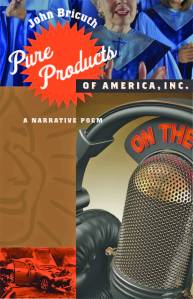 Pure Products of America, Inc.
Pure Products of America, Inc.
A Narrative Poem
John Bricuth
This propulsive narrative poem tells the extended story of the popular born-again televangelist Ray Bob Elray—better known to all his fans as Big Bubba—his twin sons, Nick and Jesse, and his niece and adopted daughter, Donna.
“The outrageous John Bricuth has surpassed himself in this sublimely mad narrative poem about our ongoing America. There is no one quite like Bricuth. He tries to play all the notes at once and frequently succeeds. Wickedness, supernal wit, eloquence always just off the beat, and a fierce verve animate this unsettling leap into our deepening abyss. To read this poem is to imbibe a tonic for these darkening times.”—Harold Bloom
“In his hugely enjoyable new verse novel, John Bricuth recounts the rise and fall of Big Bubba, preacher, faith healer, and entrepreneur, ‘the Donald Trump of holy rollers,’ whose long-kept secret has torn his family apart. It’s a captivating story, a real page-turner, poignant yet often hilarious, told in high-energy language by a master poet.”—X. J. Kennedy
Available in November
 Pennsylvania Dutch: The Story of an American Language
Pennsylvania Dutch: The Story of an American Language
Mark L. Louden
In this probing study, Mark L. Louden, himself a fluent speaker of Pennsylvania Dutch, provides readers with a close look at the place of the language in the life and culture of two major subgroups of speakers: the “Fancy Dutch,” whose ancestors were affiliated mainly with Lutheran and German Reformed churches, and conservative Anabaptist sectarians known as the “Plain people”—the Old Order Amish and Mennonites.
“Mark L. Louden is the foremost scholar of Pennsylvania Dutch. A significant contribution to linguistic, sociolinguistic, historical, and anthropological scholarship, his book is extensively researched, accessible, and filled with a wealth of language examples that will appeal to a wide audience.”—Karen Johnson-Weiner, SUNY Potsdam, coauthor of The Amish
Available in January 2106
 Narrating 9/11: Fantasies of State, Security, and Terrorism
Narrating 9/11: Fantasies of State, Security, and Terrorism
edited by John N. Duvall and Robert P. Marzec
Narrating 9/11 challenges the notion that Americans have overcome the national trauma of the terrorist attacks on the World Trade Center and the Pentagon. The volume responds to issues of war, surveillance, and the expanding security state, including the Bush Administration’s policies on preemptive war, extraordinary rendition, torture abroad, and the suspension of privacy rights and civil liberties at home.
Touching on some of the mainstays of 9/11 fiction, including Jonathan Safran Foer’s Extremely Loud & Incredibly Close and John Updike’s Terrorist, the book expands this particular canon by considering the work of such writers as Jess Walter, William Gibson, Lauren Groff, Ken Kalfus, Ian McEwan, Philip Roth, John le Carré, Laila Halaby, Michael Chabon, and Jarett Kobek. Narrating 9/11 pushes beyond a critical focus on domestic realism, offering chapters that examine speculative and genre fiction, postmodernism, climate change, and the evolving security state, as well as the television series Lost and the film Paradise Now.
Available in September
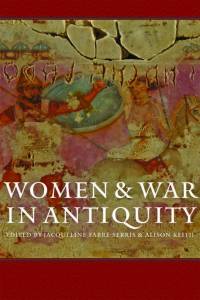 Women and War in Antiquity
Women and War in Antiquity
edited by Jacqueline Fabre-Serris and Alison Keith
The martial virtues—courage, loyalty, cunning, and strength—were central to male identity in the ancient world, and antique literature is replete with depictions of men cultivating and exercising these virtues on the battlefield. In Women and War in Antiquity, sixteen scholars reexamine classical sources to uncover the complex but hitherto unexplored relationship between women and war in ancient Greece and Rome. They reveal that women played a much more active role in battle than previously assumed, embodying martial virtues in both real and mythological combat.
“A fascinating, intellectually stimulating, and useful volume, Women and War in Antiquity sheds important new light on a complex issue while offering penetrating interpretations at the intersection of history and literature. This excellent book should interest scholars far beyond those specializing in Greco-Roman culture.”—Kurt Raaflaub, Brown University, coeditor of Raymond Westbrook’s Ex Oriente Lex: Near Eastern Influences on Ancient Greek and Roman Law
Available in November
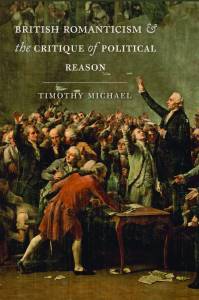 British Romanticism and the Critique of Political Reason
British Romanticism and the Critique of Political Reason
Timothy Michael
What role should reason play in the creation of a free and just society? Can we claim to know anything in a field as complex as politics? And how can the cause of political rationalism be advanced when it is seen as having blood on its hands? These are the questions that occupied a group of British poets, philosophers, and polemicists in the years following the French Revolution. Timothy Michael argues that much literature of the period is a trial, or a critique, of reason in its political capacities and a test of the kinds of knowledge available to it. This book bridges for the first time two traditional pillars of Romantic studies: the period’s politics and its theories of the mind and knowledge. Combining literary and intellectual history, it provides an account of British Romanticism in which high rhetoric, political prose, poetry, and poetics converge in a discourse of enlightenment and emancipation.
“Ambitious, well executed, and timely, this book provides valuable insight into some of the most abiding questions of Romantic studies.”—Charles W. Mahoney, University of Connecticut, editor of A Companion to Romantic Poetry
Available in December
Comments Off on Fall books preview: literature, language, & classics
Filed under Ancient, Classics, Literature, Poetry, Poetry, Publishing News
Valentine’s Day crush: heartthrobs and pinup picks for Jane Austen’s characters
Guest post by Janine Barchas
If Lydia Bennet hung celebrity pinups above her bed, whom might she have singled out among the rich and famous from the Georgian era?
The following speculations are rooted in historical truth. Celebrity culture was in full swing when Jane Austen was born in 1775. Although hers was the age before the photograph, painted portraits of the rich and famous were routinely reproduced by engravers and sold as inexpensive prints. These black and white reproductions circulated images of famous actors, politicians, naval heroes, and members of the so-called bon ton as pinups for the middling consumer. In this manner, the elegant paintings of even Sir Joshua Reynolds—England’s greatest portraitist—functioned as the modern photographs of Annie Leibovitz do today, making it hard to say whether he recorded or created celebrity with his art. London teemed with well-stocked print shops from which to select this poster-art equivalent of the Georgian era.
In my book Matters of Fact in Jane Austen: History, Location, and Celebrity I trace Austen’s allusions to celebrities through her sly borrowings of names such as Dashwood, Wentworth, Woodhouse, Fitzwilliam, D’Arcy, and Tilney—powerful real-world surnames with tremendous political and historical cachet for Austen’s generation. Valentine’s Day seems like the right occasion to imagine the next logical question (slightly less scholarly perhaps, but not less important): what people might Jane Austen’s characters have admired or hung up in their rooms?
Austen herself connects her fictional characters with celebrity portraits in a letter dated 24 May 1813, written to her sister Cassandra. On that day Jane attended the first-ever retrospective of Reynolds’s work. She writes that during her visits to London’s art galleries she looks for “Mrs Bingley” and “Mrs Darcy” on the walls—indicating that her fictional characters may have been inspired by actual celebrities. She writes being “ very well pleased … with a small portrait of Mrs Bingley, excessively like her” in the Exhibition in Spring Gardens, but that she has not yet found “one of her Sister … Mrs Darcy.” Although she declares that there is “no chance of her in the collection of Sir Joshua Reynolds’s Paintings which is now shewing in Pall Mall, & which we are also to visit,” she jokingly predicts “I dare say Mrs D. will be in Yellow.”
Since neither Austen nor her sensible heroines were mere groupies, it is predominantly her minor characters that I suspect of having celebrity pinups in their rooms.
Over Lydia Bennet’s bed: “Portrait of Mrs. Abingdon as Miss Prue”

Current title: “Mrs. Abingdon (c. 1737-1815).” Location: Yale Center of British Art. For more info see No. 103 at http://www.whatjanesaw.org.
At sixteen, Lydia shows herself “the most determined flirt that ever made herself and her family ridiculous.” This portrait of Frances Barton, the well-known actress who grew up in the slums of Drury Lane, became an icon of flirtation—the Georgian equivalent of Marilyn Monroe on a subway grate. After marrying her Irish music master, Mrs. Abington took to the stage and became known for her uninhibited comic roles. Reynolds paints Fanny in the character of Miss Prue from Congreve’s Love for Love, a famous comic part. The somewhat vulgar pose, which shows her leaning on the back of a chair with her thumb at her mouth, is meant to reflect the coy flirtations of the play’s country ingénue. In this context, even the lapdog adds to the sexual innuendo.
In Kitty Bennet’s room: “Portrait of Kitty Fischer as Cleopatra”

Current title: “Catherine Fisher (Kitty) (d. 1767)” or “Cleopatra Dissolving the Pearl.” Location: Kenwood House, London. For more info see No. 132 at http://www.whatjanesaw.org.
Although Kitty “will follow wherever Lydia leads,” she might have relished her unique connection to the celebrated Kitty Fischer—the most prominent London courtesan of the eighteenth-century, whose best-known portrait (also by Reynolds) likened her to a modern Cleopatra. Legend has it that Cleopatra made a bet with her lover Mark Antony to see who could spend the greater fortune on a meal. She won by dissolving a large and valuable pearl in vinegar (some say wine), defiantly drinking down the concoction to show her disdain for wealth. Kitty Fisher’s extravagance was similarly the stuff of legend: she ate a £100 bank note (the equivalent of a year’s salary for the middling class) on buttered bread, savoring the shock value this produced in her companions. By comparing Fischer to Cleopatra, the portrait counterbalances the courtesan’s legendary recklessness with the gravity of history. Due to Fischer’s dubious celebrity, the diminutive “Kitty” for Catherine was, Austen surely knew, associated in popular culture with loose morals.
In Mrs Bennet’s sitting room: “Portrait of Mrs Baldwyn”

Current title: “Mrs. Baldwin (1763-1839).” Location: Bowood House, Wiltshire. For more info see No. 25 at http://www.whatjanesaw.org.
Although expressions of fandom are usually confined to the bedrooms of young people, Mrs Bennet—who insists upon her equal fondness for sea bathing and redcoats—is not a woman likely to be outdone by her youngest daughters. Imagine therefore this portrait of the standout Jane Baldwyn somewhere near the Bennet stash of smelling salts. Although as the daughter of a Greek merchant Jane was not a woman of title, she married the British Consul to Alexandria. Back in England, Jane’s exotic features received much notice from society. Mrs Baldwyn’s costume has been interpreted by some as the national costume of a Greek lady and others as a fancy dress worn at a costume ball given by the King. Mrs Baldwyn, like Mrs Bennet, was not a woman afraid of attracting notice.
Above the desk of Marianne Dashwood:
“Portraits of Elizabeth and Francis Russell”
 Current title: “Lady Elizabeth Keppel (1739-68).” Location: Woburn Abbey. For more info see No. 22 at http://www.whatjanesaw.org. |
 Current title: “Francis Russell, Marquess of Tavistock (1739-67).” Location: Blenheim Palace. For more info see No. 128 at http://www.whatjanesaw.org. |
The dashing Marquis of Tavistock and his young wife, Elizabeth, were the type of doomed celebrity couple that Marianne Dashwood, with her Romantic “passion for dead leaves”, cherishes. At 25, the beautiful Lady Elizabeth Keppel wedded the well-traveled and handsome Francis Russell, Marquess of Tavistock. After the arrival of a son, the Russells were England’s poster couple for wedded bliss—additionally blessed with court connections, shared intellectual interests, and wealth. Three years into this happy marriage, Francis was tragically killed by a fall from his horse. Within months Elizabeth, who is said to have pined away from grief, joined her young husband in death. Imagine Reynolds’s portrait of Elizabeth, dressed in the bridesmaid gown that she wore to the wedding of George III and Queen Charlotte, as an omen of tragic romance above the writing desk where Marianne composes her tear-stained letters to Willoughby.
In Mary Crawford’s boudoir: “Portrait of Mary Beauclerk, Lady Charles Spencer”

Current title: “Lady Charles Spencer (1743-1812).” Location: Private Collection. For more info see No. 97 at http://www.whatjanesaw.org.
In 1762, Mary Beauclerk, daughter of Lord Vere, married Lord Charles Spencer, second son of the third Duke of Marlborough, a famous politician. Unusual for a woman, Mary had her portrait painted with her horse. She wears a striking red riding habit cut in the manner of a man’s frock coat—with a waistcoat fastened in the masculine way from left to right. While the costume, which includes a long skirt, stops well short of androgyny, the portrait’s unconventional masculine flair conveys a woman with a daring sense of style and forceful personality. Given the emphasis in Mansfield Park on the appropriation by Mary Crawford of poor Fanny Price’s horse as a symbol of upstart ambitions to unseat Fanny in Edmund’s affections, Mary’s admiration of this society hostess (and namesake) seems almost certain.
Over the sickbed of Louisa Musgrove: “Portrait of Captain John Hamilton”
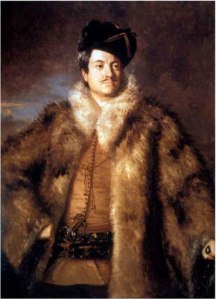
Current title: “Captain John Hamilton (d. 1755).” Location: Abercorn Heirlooms Trust. For more info see No. 42 at http://www.whatjanesaw.org.
After her fall along the Cobb, Louisa Musgrove likely stares long and hard at portraits of celebrity naval officers such as John Hamilton, a legendary eighteenth-century sailor. As testimony to his travels and, possibly, to his famed good humor, Hamilton is flamboyantly dressed in the costume of a Hungarian hussar, complete with mustache, fur busby, small dagger, and a dramatic fur coat that might be bear, fox, or even wolf. John Hamilton accompanied George II from Hanover in 1736 on a ship called Louisa, a fact that the impressionable Miss Musgrove is free to interpret as significant. He was eventually appointed captain of a ship that tragically struck what became known as Hamilton shoal in commemoration of how it caused him and most of his crew to drown.
If, like Jane Austen herself, you enjoy a little celebrity spotting, you might visit the digital recreation of the 1813 art exhibition that she attended: www.whatjanesaw.org. All of the above portraits by Sir Joshua Reynolds, and over a hundred more, hang in the What Jane Saw e-gallery in precisely the same arrangement on the walls as witnessed by Jane Austen on 24 May 1813. This Valentine’s Day, go ahead and get a crush on someone Austen knew!
 Janine Barchas, is Professor of English at University of Texas where she teaches Austen in Austin. She is author of Matters of Fact in Jane Austen: History, Location and Celebrity and the creator of What Jane Saw , a digital reconstruction of an 1813 art gallery. As co-curator of the “Will & Jane” exhibition at The Folger Shakespeare Library in 2016, she’ll next explore the parallel afterlives of Shakespeare and Austen and their rise to literary superstar status.
Janine Barchas, is Professor of English at University of Texas where she teaches Austen in Austin. She is author of Matters of Fact in Jane Austen: History, Location and Celebrity and the creator of What Jane Saw , a digital reconstruction of an 1813 art gallery. As co-curator of the “Will & Jane” exhibition at The Folger Shakespeare Library in 2016, she’ll next explore the parallel afterlives of Shakespeare and Austen and their rise to literary superstar status.
Filed under Fine art, For Everyone, Libraries, Literature
Treat yourself this holiday season: subscribe to a JHUP JOURNAL!
By Janet Gilbert, JHUP Journals Staff
After two hours at the mall, my feet are burning in my pointy work shoes. I hoist my packages up the first set of ten and the second set of five steps to my front door, and toss the bags of gifts in the foyer. I’ll wrap them tomorrow. Because now it’s time for a cup of hot cocoa by my garish tree replete with homemade egg-carton and coffee-scoop ornaments—and the latest issue of The Hopkins Review.
I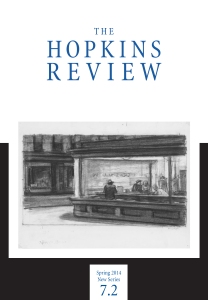 like to treat myself. And to me, this particular journal from our catalog of more than 80 provides slow-down-and-reflect moments in a hurry-up-and-do-something world. It’s a gift I enjoy all year, but appreciate most at this time when I have so many extra-festive elfish tasks.
like to treat myself. And to me, this particular journal from our catalog of more than 80 provides slow-down-and-reflect moments in a hurry-up-and-do-something world. It’s a gift I enjoy all year, but appreciate most at this time when I have so many extra-festive elfish tasks.
Why not treat yourself to a subscription to an academic journal this year? It may be the smartest gift you give yourself: time to consider a different perspective, time to think. As a graduate student in the Hopkins Writing program, my natural inclination would be to pick up the Sewanee Review, one of the most storied literary quarterlies in the United States. But wait, Studies in American Fiction offers a tasty smorgasbord of writers from a range of historical periods, and Callaloo serves up the very best original work by writers and visual artists of African descent worldwide. Callaloo Art, the new fifth issue devoted to visual art and culture of the African Diaspora, is simply an inspirational and lush read.
 Enough about me. If you are a historian, don’t you deserve Reviews in American History? It’s one journal that throws a window wide open on all areas of American history: culture, gender, law, politics, the military, and more.
Enough about me. If you are a historian, don’t you deserve Reviews in American History? It’s one journal that throws a window wide open on all areas of American history: culture, gender, law, politics, the military, and more.
If you are a health professional, you might have to sit down to make your pick: Bulletin of the History of Medicine will inform your work by providing a social, cultural, and scientific context for all kinds of medical practices and procedures. Journal of Health Care for the Poor and Underserved will spark your advocacy, and Narrative Inquiry in Bioethics will provide you with first-person patient and practitioner narratives that will do more than inform you—they will move you.
 Lest you think we’ve forgotten you, person-keenly-interested-in-all-things-French-and-medieval, we have the perfect gift: Digital Philology. With an electronic subscription, you can sit in your living room with your laptop and transport yourself effortlessly and immediately to the library of the Universidade de Coimbra in Portugal to study a little-known manuscript from the thirteenth century.
Lest you think we’ve forgotten you, person-keenly-interested-in-all-things-French-and-medieval, we have the perfect gift: Digital Philology. With an electronic subscription, you can sit in your living room with your laptop and transport yourself effortlessly and immediately to the library of the Universidade de Coimbra in Portugal to study a little-known manuscript from the thirteenth century.
My point is, take a vigorous, year-long intellectual adventure from the seat of your most comfortable armchair. From African American Review (African American literature, theatre, film, poetry and culture) to Feminist Formations (feminist, gender, and sexuality studies) to Victorian Periodicals Review (editorial and publishing history of Victorian periodicals), we’ve got an academic journal for you.
Why not feed your intellect and restore your soul this season by giving yourself a subscription?
Best of all, you don’t have to trek to the mall. Just click on the titles below or browse our entire collection.
African American Review
Bulletin of the History of Medicine
Callaloo
Digital Philology: A Journal of Medieval Cultures
Feminist Formations
Journal of Health Care for the Poor and Underserved
Narrative Inquiry in Bioethics: A Journal of Qualitative Research
Reviews in American History
Studies in American Fiction
The Sewanee Review
The Hopkins Review
Victorian Periodicals Review
Comments Off on Treat yourself this holiday season: subscribe to a JHUP JOURNAL!
Filed under African American Studies, American History, American Studies, Ancient, Bioethics, Caribbean Studies, Classics, Cultural Studies, Ethics, Gender Studies, Health and Medicine, History, History of Medicine, Journals, Journals, Literature, Women's History
Fairies in the “Fairy Way”
Chapter and Verse is a series that features JHU Press authors and editors discussing the literary landscape of poetry and prose, whether their own creative work or the literature of others.
Guest post by Kevin Pask
The “fairy way of writing” is a phrase that came into currency with the English writer Joseph Addison in the early eighteenth century. Like others before me, I have adopted it for my own purposes, which only lightly touched on the world of children’s fairy stories. Nevertheless, I did some additional “research” into the world of the children’s fairies with my two daughters, Emma and Violet, who were young children when the book project that became The Fairy Way of Writing began.
I don’t remember having a particular interest in fairies as a child. In fact, I remember having a strong taste for children’s historical fiction. I was particularly fond of the We Were There series of historical fictions for children, and my copy of Strange But True Football Stories was well-thumbed. I don’t remember actually reading the old fairy tales. What I do remember is all the many ways in which mass media had absorbed and restructured those tales for children. My own favorite was the “Fractured Fairy Tales” that appeared on The Rocky and Bullwinkle Show. From an early age, maybe around nine or ten, I became a reader of Tolkien, and that, rather than more traditional fairy stories, was my entry into fantasy. I even remember going into my sister’s room to listen to my mother read it aloud after I had already read the books for the first time.
Why do girls gravitate more than boys to the domain of fairy? My older daughter, Emma, had the Sky Dancer toy that was supposed to be wound up and, fairy-like, fly around the room. I don’t remember that it ever successfully did more than collide with the nearest large object, but that didn’t stop us from following the TV show, Sky Dancers, that had apparently been developed around the toy, and which featured the fearless Queen Skyla and her Sky Dancers battling against the wicked Sky-Clone, who had killed her husband, King Skyler. The entire Sky Dynasty was itself deposed—and after only one season!—by the arrival of new regulations for more “informative” children’s programming in the United States.
Emma was also a reader of L. Frank Baum’s Oz books, which prominently featured the role of girls, sometimes girls who were also boys. (Baum was the son-in-law of the prominent feminist activist Matilda Joslyn Gage.) Violet became a devoted reader of the Fairy Realm series, by the Australian writer Emily Rodda, a children’s series that transplants the “fairies at the bottom of the garden” to an Australian setting. Some of the books in the series sported sparkly covers. Both Sky Dancers and Fairy Realm were clearly marketed to girls.
The fairy, or the fairy princess has become part of the girl’s rite of passage. I still possess, in my office, Violet’s nursery school drawing of four butterflies charmingly floating between flowers and clouds, which her teacher has helpfully labeled with Violet’s own description: “The four fairyflies are watching the clouds go by.” In another drawing from the same period, Violet had drawn a picture of a window looking out into the night world to illustrate a wish: “I wish I was magical.”
The fairy queen, I think, still lies somewhere in the background of the ongoing romance of the fairy world. In medieval legend, the fairy queen could be dangerous as well as seductive. The older fairies were not, of course, uniquely female, but the legend of the fairy enchantress has been the part of the fairy domain that most successfully survived in the modern world. The erotic side of this legend is readily accessible. Just do a Google Image search for “fairies,” and you will encounter the full range of both childhood and eroticized fairies. Domesticated as they often are, they still carry something of a specifically feminine power that has survived into our own time.
 Kevin Pask is an associate professor of English at Concordia University and is author of The Fairy Way of Writing: Shakespeare to Tolkien, published by Johns Hopkins University Press, and The Emergence of the English Author: Scripting the Life of the Poet in Early Modern England.
Kevin Pask is an associate professor of English at Concordia University and is author of The Fairy Way of Writing: Shakespeare to Tolkien, published by Johns Hopkins University Press, and The Emergence of the English Author: Scripting the Life of the Poet in Early Modern England.
Filed under Behind the Scenes, Chapter & Verse, Literature, Writing


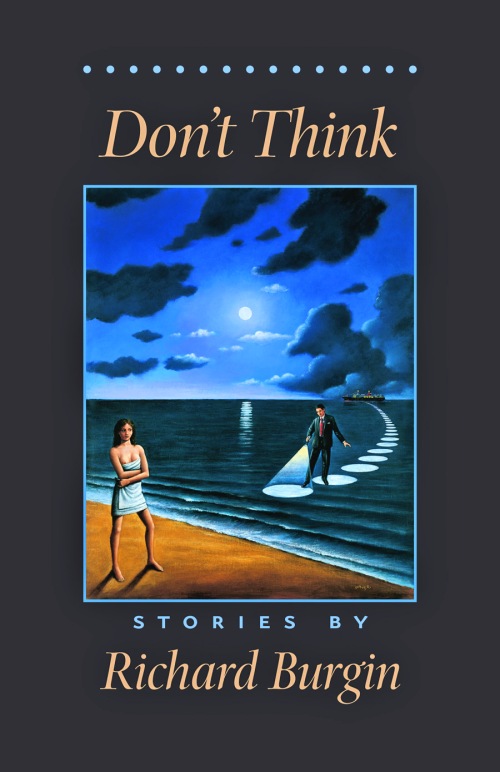



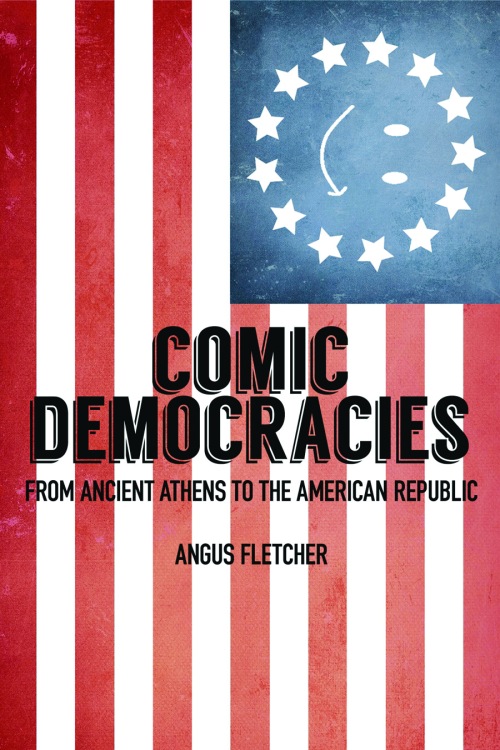








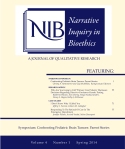

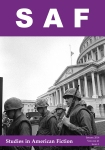
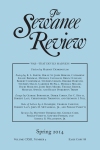

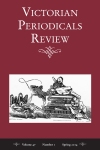

You must be logged in to post a comment.